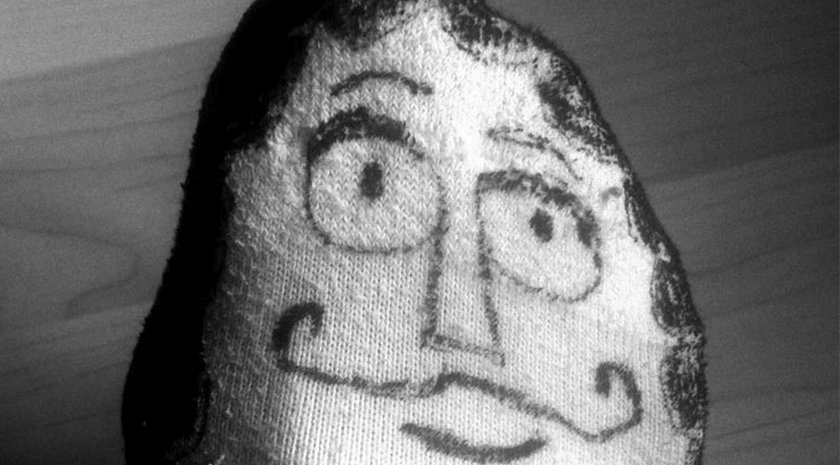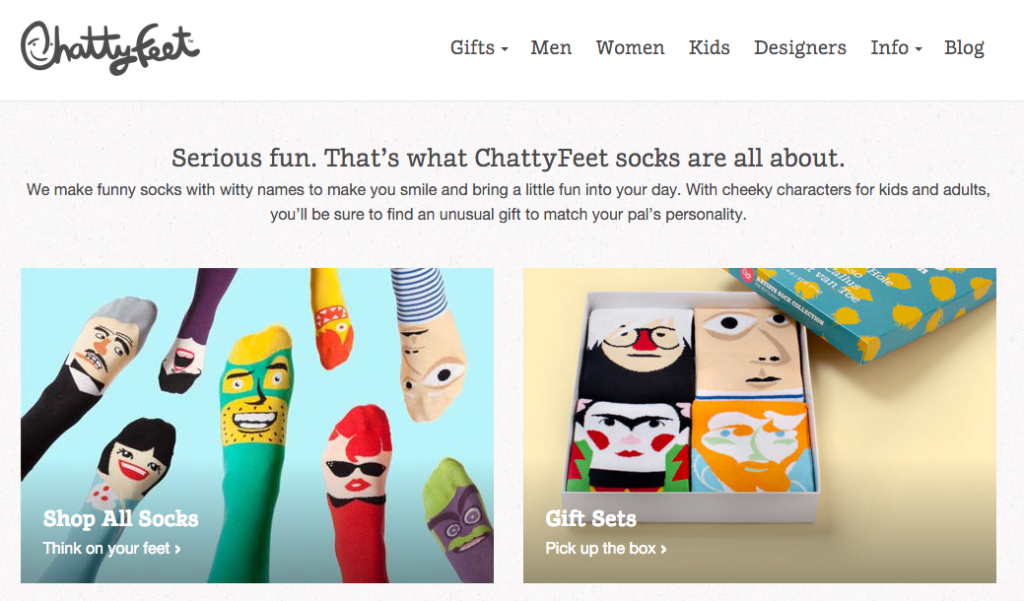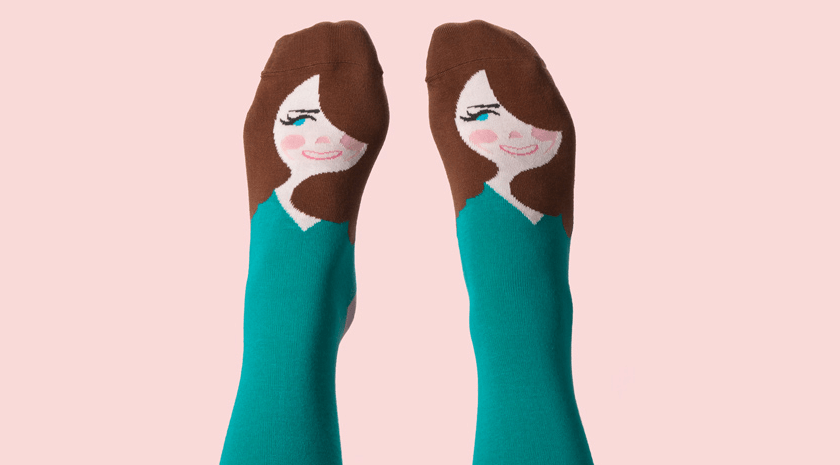ChattyFeet Socks started as just another one of Gil Kahana and Humberto de Sousa’s funny ideas.
The two had met in university, where they bonded over their shared interests: innovation, design technology, and the importance of a great sense of humor. One night, at a dinner party with friends, they started pondering what would happen if their socks could talk.
“I just twisted my feet in the air and I thought, ‘Wow! It’d be cool if my sock could be animated like a sock puppet,'” Gil says.
Three years later, ChattyFeet Socks has bloomed into a successful eCommerce business that sells in more than 10 countries. Here’s how the two turned an idea into a reality.
Step 1: Commitment
Gil and Humberto decided to give the idea a go, pledging to meeting once a week, which wasn’t easy, considering they were both working full time.
They didn’t have money for an office, so they began meeting in the Barbican Centre in London. There, they used the free wi-fi and brainstormed how to bring the sock illustrations to life.
Step 2: User Research
Gil’s background is in UX and Humberto specializes in web design and branding. Their work experience taught them that successful brands don’t just sell a product: they sell a story.
The key to selling this story effectively is knowing your product, knowing your customers, and knowing your brand. They began with user research, taking to the streets to interview people about how they expressed themselves with fashion.
One of the interesting insights they found was their certain fashion items provide greater possibility for personal expression. It’s much easier for people to get crazy with a scarf or socks than a shirt or coat.
This insight – that objects that are not always visible can be great opportunities for self expression – inspired them to create socks with personality.
They got started with research and created a prototype, the first of which was just a white sock with a black marker face drawn on.

They used the prototype to test their product, to see how it would work as a sock puppet and thought about stories they could tell around the brand.
Step 3: Design & Branding
After the research, they started working on the branding of the product. Humberto began creating the visual identity, including the logo, stickers, and business cards.
When it came to designing the products, they agreed that in those beginning stages it was key that they focused on manageable, realistic goals.
Many eCommerce businesses fail because they try to do too much at once. The ChattyFeet Socks co-founders focused on creating just four characters at the beginning, so their goals would be achievable.
Essential Tips for Building an eCommerce Marketing Plan
Step 4: Product Production
Once they had the first four characters ready, their next challenge was producing the socks. And finding a producer wasn’t easy.
“When you’re a small company, producers don’t really want to work with you because they’re looking for big fish and large quantities.”
They got a list of sock producers online and connected them with email addresses and phone numbers. They began inquiring about the minimum quantities producers would need to work with them and learned more about the best way to apply their designs onto socks.
“Getting a sample is the easy part. The tricky part is finding a producer that delivers high-quality goods at a reasonable price. Unless you know someone already, finding a producer is just trial and error,” Humberto says.
They learned that when working with mass produced products, it’s vital to keep an eye out for mistakes, which can be really costly and put a dent in cash flow.
Gil and Humberto went over the stock one by one and found a lot of rejects, so they negotiated a lower price with the producer.
As exciting as it was to see their designs mass produced for the first time, standing around the apartment filled with twelve huge boxes of inventory was also stressful.
“I just remember realizing that I was going to have to sell this somehow – and I thought okay, how are we going to make this happen?”Step 5: Start Selling
ChattyFeet needed a website. Originally they hired a developer to build the entire site from scratch, but they soon came upon a smarter and simpler solution: building and customizing their site via Shopify.
They envisioned ChattyFeet as a funky, quirky brand and wanted their site and messaging to match this.

“In addition to customizing the logo and design, we did things like change the wording of the automated messages, from ‘Dear’ to ‘Hi’ to match the tone of our brand,” Gil says. Small changes in micro-content like this add up and have a big impact on the impressions customers get of a brand.”
They also released videos with their sock puppets on their YouTube channel, experimenting with video as a medium to tell their sock characters’ stories.
After the website, videos, product photos, and everything else were done – ChattyFeet Socks was ready to launch. Now, the challenge was making it grow.
Step 6: Growth
When ChattyFeet launched, they didn’t just rely on online sales. They hit the ground running, even suiting up in their winter jackets and heading out to sell their products in local markets, like the famous Camden Market.
“It was a very good physical experience because we saw how people reacted,” Humberto says. Even though they weren’t hugely successful in selling their products in the market, “It was more of a research exercise, seeing what it means to sell this character, seeing what people say about your product.”
Gil and Humberto explain that for those selling online, there’s a massive advantage in the experience of selling your products in the physical space because you learn a lot of things that it would take much longer to learn online.
They also opted to sell their socks on other sites, like Not on the High Street, an online store that sells creative items from small businesses.
They had tried selling on Amazon and eBay, but found that because of their niche product and the demographics of the sites, Not on the High Street was the best fit for them.
Although selling their products on other sites meant that they lost a bit of profit to commission, ChattyFeet started to get more sales and were able to gain insight into how their product performed. It also allowed them to reach a bigger audience and diversify their income sources.
As they continued to grow, they wanted to keep going but had “a bit of a cash flow issue.”
They decided to take to Kickstarter to raise funds for their project.
Not only did they raise £7500 – enough to fund the cost of the second collection – but they also grew awareness for the brand. They were able to show proof of their success so far, which was helpful to their Kickstarter story because people had some faith in the brand.
During this time, “The question I keep on asking myself more and more is: Who cares about our product?” Gil says.
They hypothesized that illustrators or puppeteers would like what they were doing, so they started to contact people from this field. Targeting a specific community proved itself to be a good strategy.
They also continued to grow on social media. On Instagram, ChattyFeet has very high engagement. Again, this is because they really understand the story they are selling as well as the niche community they’re targeting.
Knowing their audience was also key during their marketing. One of their great moves was to send samples of their product to British Vogue. British Vogue Instagrammed a photo of their Kate Middleton sock, which got them tons of new exposure.
“We sent Kate Middleton because she is a fashion icon. If we were sending Professor Brian Sox to British Vogue they probably wouldn’t care,” Gil explains.

Conclusion
Gil and Humberto have some pieces of advice for new business owners:
“You always have to ask yourself who can do some parts of your business better. For example, we are great at creating characters but there are people who can write better blog posts than us, people who can do shipping better than we do. We actually did it by ourselves for one and half years – carrying bags of hundred packages to the post during Christmas time – before we realized that this is not an effective way to run the business.”
In addition to finding experts to help, they remind businesses that the best job doesn’t feel like work.
“Anyone who is starting their own business really needs to find what they’re passionate about first. Passion is the fuel that will keep you going over the years, especially when things get tough at times.”
Visit ChattyFeet Socks.


